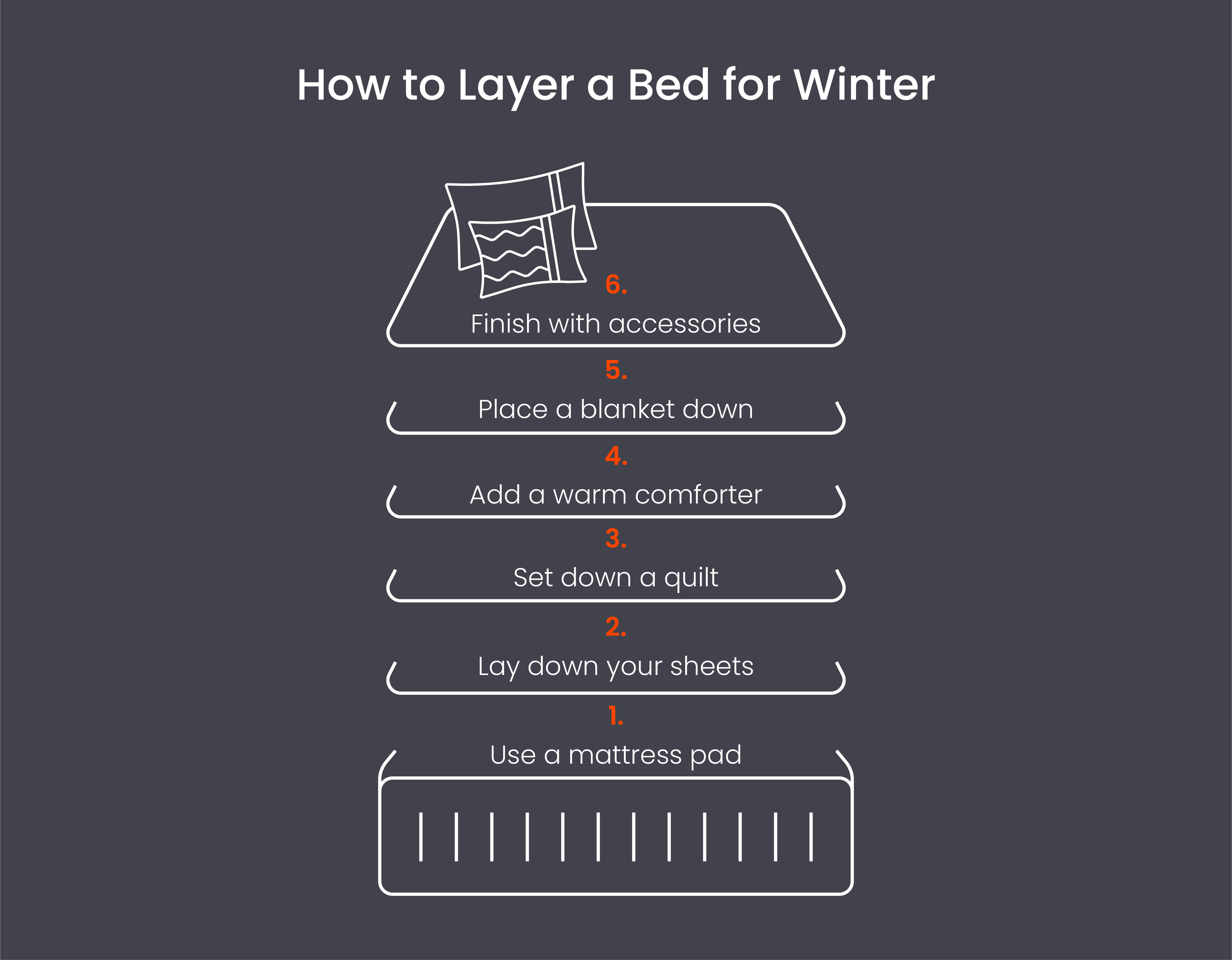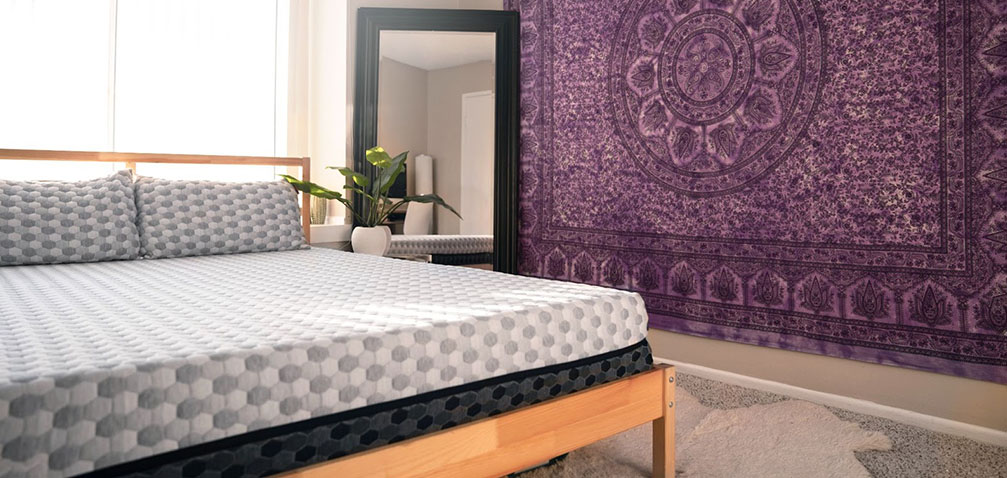One way to stay warm is to layer your bed with blankets, comforters, and sheets to trap your body heat while you sleep, keeping you warm all night long. When layering blankets for winter, consider adding a variety of different sheets and covers. In this guide, we’ll go over how to layer a bed for winter. Take a look.
- Why Do You Need to Layer Your Bedding for Winter?
- How Do You Layer a Bed for Winter?
- Tips for Improving Sleep in the Winter
- Get Cozy with Layla Sleep
Why Do You Need to Layer Your Bedding for Winter?
Everyone needs quality sleep. Unfortunately, your room can get too cold when the temperatures drop, resulting in tossing and turning and poor sleep quality. Layering blankets can offer more comfort, coziness, and warmth, helping you fall asleep faster and stay asleep without shivering. Layers also make it easy to adjust your temperature while you sleep. For example, if it gets too warm under the covers, you can take off a layer to find your ideal sleep temperature.
How Do You Layer a Bed for Winter?
Layering a bed for winter allows you to use multiple pieces to accurately adjust your warmth based on the temperature of your room. If you live in a location where winter temperatures can shift drastically, layering can help you prepare for warmer and colder nights. Here’s how to layer a bed for winter:

1. Use a mattress pad
When layering blankets for your winter bed, consider more than just the top layers. A mattress pad can keep you insulated by adding an extra layer to your mattress. Mattress pads are also used to add comfort and improve sleep quality by trapping heat around your entire body, including under it. Mattress toppers go under your fitted sheet and can add more pillowy softness to your mattress while reducing any lumps and bumps it may have from years of use.
Of course, if you don’t want your mattress topper to absorb your body heat, you can find a breathable mattress pad like the Layla Memory Foam Topper, designed to regulate your body temperature to keep you cool at night. A cooling mattress topper can prevent you from getting too hot underneath all your layers, reducing the chances of waking up in the middle of the night drenched in sweat.
2. Lay down your sheets
Consider adding lightweight, breathable sheets that can help regulate your body temperature in the winter. In addition, you can use a fitted sheet and a top sheet made from materials that will keep you most comfortable at night. The best winter bedding materials include:

- Flannel sheets: Flannel is a popular material for winter bed sheets because it’s soft and traps heat. Flannel sheets are made from cotton but have a looser weave than other fabrics. Unfortunately, flannel is not a year-round fabric as it can get too hot, but it’s ideal for cold winters.
- Wool sheets: Wool sheets are another popular choice for cold climates because they’re incredibly warm. Unfortunately, wool bedding can be itchy, depending on the quality of the sheets. In most cases, wool makes a better material for inserts, such as duvet inserts, or when used in pillows and mattress pads.
- Cotton sheets: Cotton sheets are affordable and breathable yet remain warm, especially when layered. Cotton is ideal for year-round use, and you can find sheets at almost any price point. But, of course, the more you’re willing to pay, the higher quality and softer the sheets will be.
- Bamboo sheets: Bamboo sheets are another popular choice for year-round use. While often talked about as ideal summer bedding because bamboo sheets are breathable and moisture-wicking, they’re actually temperature regulating. Therefore, bamboo helps to keep you cool in warm weather and warm in cool weather. It’s also incredibly durable, soft, and sustainable.
- Fleece sheets: Another popular winter sheet is fleece, which can be made from synthetic fibers, natural fibers, or a combination of both. Fleece is soft to the touch and keeps you warm, but also has great moisture-wicking properties.
- Sateen sheets: Sateen sheets are made from cotton plants using mercerized fibers and sewn with a satin weave. During winter, sateen sheets can keep you warm, thanks to their ability to retain heat.
3. Set down a quilt
A quilt is a thin blanket with batting, a thin layer of insulation, between two layers of fabric. It’s different from a comforter because it’s thin and flat. Quilts are also more breathable than many comforters because they’re lightweight and don’t contain as much fill. Having a quilt as your bottom layer of warm bedding in the winter can help you adjust your temperature at night. For example, if you get too hot, you can take off the top layer and sleep with only the quilt.
Depending on how warm you expect to get while you sleep, you can also use the quilt as your top layer. Of course, every quilt is different, and some are designed with heavier materials for winter, while others are designed lighter for summer. When choosing the right quilt for layering your winter bedding, consider how much heat you want to trap under the blankets.
4. Add a warm comforter
A warm comforter is necessary during the winter when trying to stay warm at night. Comforters are also lofty and offer more weight for added comfort, and there are many different options to choose from, depending on how cold your sleep environment gets and how warm you sleep. Here are a few different types of comforters for winter:

- Cotton comforter: Cotton is a breathable material that’s ideal for warmer climates. However, they can also be quite warm depending on the fill power. A cotton comforter with a higher fill power and more loft offers more insulation for the cold winter months.
- Down comforter: A down comforter is one of the warmest comforters available for winter. Duck and goose down are insulating materials, and the higher the fill power, the warmer the comforter will be. Of course, down comforters aren’t ideal for everyone, especially those who suffer from allergies.
- Down alternative comforter: Down alternative comforters are slightly cooler than down comforters, but they can be warm, depending on the fill power. Since down alternative comforters are available in various weights, you should choose the one that’s best for you.
- Wool comforter: Wool comforters typically have wool filled with a cotton shell since wool can be a scratchy material. Of course, high-quality wool is soft and breathable, so you may be able to find a 100% wool comforter, depending on where you shop. Wool is another insulating material ideal for winter, but it can get too hot for some people.
- Linen comforter: Linen is a summer fabric, but since it can help with temperature regulation, it may be a good comforter for layering to prevent you from overheating at night. Since linen is breathable, you can still layer up with it to keep yourself warm. Additionally, it has moisture-wicking properties, so if you get too hot under the covers, it will remove sweat from your skin and help it evaporate faster.
Read the comforter buying guide for more information to help you find the best winter comforter.
5. Place a blanket down
Adding a blanket on top of the comforter can make your bed feel cozier. It can also add more weight, which can help you feel more relaxed and comfortable. A light blanket on top of your comforter gives you a layer to remove if you get too warm. There are many winter blanket types to choose from, so always consider their warmth and weight.
If you love layering your bed in the winter because you enjoy the added weight from different blankets and comforters, consider using a weighted blanket. When buying a weighted blanket, you can get the same benefits as multiple blankets with fewer layers without getting too warm while you sleep.
6. Finish with accessories
After adding all your sheets, blankets, and comforters, don’t forget about other ways to make your bed more comfortable. Finish your layering with accessories like comfortable pillows and throw blankets.
Tips for Improving Sleep in the Winter
Getting quality sleep in the winter may seem difficult. Even with the heat on, you may get cold, especially if you sleep by a window. Here are a few tricks to help improve your sleep quality in the winter.

- Reduce screen time before bed: Screens emit blue light that can trick your brain into thinking it should be awake even after the sun has set. Reducing screen time before bed can help relax your mind and help it get ready for bed.
- Get plenty of light throughout the day: Your circadian rhythm, also known as your sleep-wake cycle, is why you feel more awake when the sun is up and tired after it goes down. Unfortunately, depending on where you live, you might experience days with barely any sun in the winter. Additionally, days are shorter in the winter, so the sun sets earlier, which can disrupt your natural sleep cycle and cause winter fatigue during the day. Getting more light during the day can help you feel more alert while preparing your brain for bed because it will help regulate your sleep cycle.
- Set the right room temperature: The best temperature for sleep depends on your preferences, but most people prefer something in the high sixties or low seventies. In the winter, you may choose to keep your heat lower at night to save money. However, you should weigh the pros and cons and whether sacrificing your sleep is worth it.
- Exercise: Getting more exercise throughout the day can help regulate your sleep cycle by allowing you to burn off more energy throughout the day so you’ll be able to fall asleep faster at night.
- Create a relaxing bedtime routine: Having a nighttime routine helps train and prepare your brain for bed. Your bedtime routine will signal your brain that it’s time to start releasing sleep hormones like melatonin to help you fall asleep faster.
Get Cozy with Layla Sleep
Layering your bed with warm bedding is a cost-effective way to stay warm while you sleep. With mattress toppers, blankets, and quilts or comforters, you can ensure a good night of sleep no matter the temperature outside. Don’t wait until the snow begins to fall to prepare your winter bed. Instead, start gathering these items to have them ready for the first cold night of the year.
Browse Layla’s selection of sleep-enhancing products to help you get quality sleep in the winter, no matter how cold it is outside.



